NCERT Class 8 Maths Chapter 8 Comparing Quantities Solutions
NCERT Solutions for Class 8 Maths Chapter 8 Comparing Quantities Exercise 8.1
Ex 8.1 Class 8 Maths Question 1.
Find the ratio of the following:
(a) speed of a cycle 15 km per hour to the speed of scooter 30 km per hour.
(b) 5 m to 10 km
(c) 50 paise to ₹ 5
Solution:
(a) Speed of cycle : Speed of Scooter = 15 km per hour : 30 km per hour
= =
Hence, the ratio = 1 : 2
(b) 5 m to 10 km
= 5 m : 10 × 1000 m [∵ 1 km = 1000 m]
= 5 m : 10000 m
= 1 : 2000
Hence, the ratio = 1 : 2000
(c) 50 paise to ₹ 5
= 50 paise : 5 × 100 paise
= 50 paise : 500 paise
ratio = 1 : 10
Ex 8.1 Class 8 Maths Question 2.
Convert the following ratios to percentages:
(a) 3 : 4
(b) 2 : 3
Solution:
Ex 8.1 Class 8 Maths Question 3.
72% of 25 students are good in mathematics. How many are not good in mathematics?
Solution:
Number of students who are good in mathematics = 72% of 25
Number of students who are not good in mathematics = 25 – 18 = 7
Ex 8.1 Class 8 Maths Question 4.
A football team won 10 matches out of the total number of matches they played. If their win percentage was 40, then how many matches did they play in all?
Solution:
40 matches the team won out of 100 matches
1 match was won out of matches
10 matches the team will won out of × 10 = 25 matches
Hence, the total number of matches played by the team = 25
Ex 8.1 Class 8 Maths Question 5.
If Chameli had ₹ 600 left after spending 75% of her money, how much did she have in the beginning?
Solution:
Let the money with Chameli be ₹ 100
Money spent by her = 75% of 100
= × 100 = ₹ 75
The money left with her = ₹ 100 – ₹ 75 = ₹ 25
₹ 25 are left with her out of ₹ 100
₹ 1 is left with her out of ₹
₹ 600 will be left out of ₹ × 600 = ₹ 2400
Hence, she had ₹ 2400 in beginning.
Ex 8.1 Class 8 Maths Question 6.
If 60% of people in a city like a cricket, 30% like football and the remaining like other games, then what per cent of the people like other games? If the total number of people are 50 lakh, find the exact number who like each type of game.
Solution:
Total number of people = 50,00,000
Number of people who like cricket = 60% of 50,00,000
= × 50,00,000
= 30,00,000
Number of people who like football = 30% of 50,00,000
= × 50,00,000
= 15,00,000
Number of people who like other games = 50,00,000 – (30,00,000 + 15,00,000)
= 50,00,000 – 45,00,000
= 5,00,000
Percentage of the people who like other games = × 100 = 10%
Hence, 10% of people like other game.





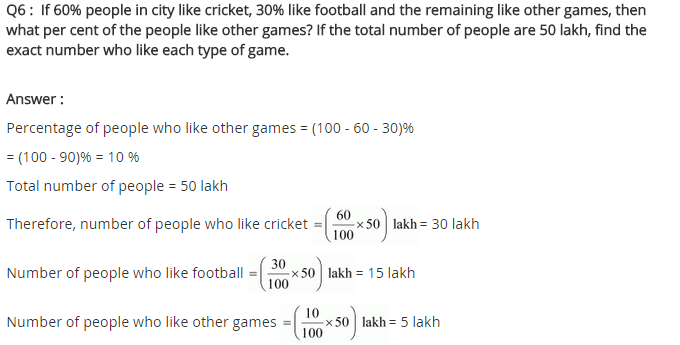

Class 8 Maths Chapter 8 Comparing Quantities Ex 8.2
NCERT Class 8 Maths Chapter 8 Comparing Quantities Ex 8.2 Solutions
NCERT Solutions for Class 8 Maths Chapter 8 Comparing Quantities Exercise 8.2
Ex 8.2 Class 8 Maths Question 1.
A man got a 10% increase in his salary. If his new salary is ₹ 1,54,000, find his original salary.
Solution:
The increased salary = ₹ 1,54,000
Increase in salary = 10%
Increase salary = Original salary × (1 + )

Hence, the original salary = ₹ 1,40,000
Ex 8.2 Class 8 Maths Question 2.
On Sunday 845 people went to the Zoo. On Monday only 169 people went. What is the per cent decrease in the people visiting the Zoo on Monday?
Solution:
Number of people visiting the Zoo on Sunday = 845
Number of people visiting the Zoo on Monday = 169
Decrease in number of people visiting the Zoo = 845 – 169 = 676
Decrease per cent
Hence, the decrease per cent = 80%
Ex 8.2 Class 8 Maths Question 3.
A shopkeeper buys 80 articles for ₹ 2,400 and sells them for a profit of 16%. Find the selling price of one article.
Solution:
Cost price of 80 articles = ₹ 2,400
Cost of 1 article = ₹ = ₹ 30
Profit = 16%
Hence, the selling price of one article = ₹ 34.80
Ex 8.2 Class 8 Maths Question 4.
The cost of an article was ₹ 15,500. ₹ 450 were spent on its repairs. If it is sold for a profit of 15%, find the selling price of the article.
Solution:
CP of the article = ₹ 15,500
Money spent on repairs = ₹ 450
Net CP = ₹ 15,500 + ₹ 450 = ₹ 15,950
Profit = 15%
Hence, the selling price of article = ₹ 18342.50
Ex 8.2 Class 8 Maths Question 5.
A VCR and TV were bought for ₹ 8,000 each. The shopkeeper made a loss of 4% on the VCR and a profit of 8% on the TV. Find the gain or loss per cent on the whole transaction.
Solution:
Cost price of a VCR = ₹ 8,000
Loss = 4%

Hence, the shopkeeper gained 2% profit on the whole transaction.
Ex 8.2 Class 8 Maths Question 6.
During a sale, a shop offered a discount of 10% on the marked prices of all the items. What would a customer have to pay for a pair of Jeans marked at ₹ 1450 and two shirts marked at ₹ 850 each?
Solution:
Marked Price (MP) of Jeans = ₹ 1,450
MP of two shirts = ₹ 850 × 2 = ₹ 1,700
Total MP = ₹ 1,450 + ₹ 1,700 = ₹ 3,150
Discount = 10%
Thus, the customer will have to pay ₹ 2,835.
Ex 8.2 Class 8 Maths Question 7.
A milkman sold two of his buffaloes for ₹ 20,000 each. On one he made a gain of 5% and on the other a loss of 10%. Find his overall gain or loss. [Hint: Find CP of each]
Solution:
SP of a buffalo = ₹ 20,000
Gain = 5%


Ex 8.2 Class 8 Maths Question 8.
The price of a TV is ₹ 13,000. The sales tax charged on it is at the rate of 12%. Find the amount that Vinod will have to pay if he buys it.
Solution:
Marked price of the TV = ₹ 13,000
ST = 12%
The required amount that Vinod has to pay = ₹ 14,560
Ex 8.2 Class 8 Maths Question 9.
Arun bought a pair of skates at a sale where the discount is given was 20%. If the amount he pays is ₹ 1,600, find the marked price.
Solution:
Let the MP of the skates be ₹ 100
Discount = ₹ 20% of 100 = ₹ 20
Sale price = ₹ 100 – ₹ 20 = ₹ 80
If SP is ₹ 80 then MP = ₹ 100
If SP is ₹ 1 then MP = ₹
If SP is ₹ 1,600 then MP = ₹ × 1600 = ₹ 2,000
Thus the MP = ₹ 2000.
Ex 8.2 Class 8 Maths Question 10.
I purchased a hair-dryer for ₹ 5,400 including 8% VAT. Find the price before VAT was added.
Solution:
Let the original price be ₹ 100
VAT = 8% of 100 = ₹ 8
Sale price = ₹ 100 + ₹ 8 = ₹ 108
If SP is ₹ 108 then original price = ₹ 100
If SP is ₹ 1 then the original price = ₹
If SP is ₹ 5,400 then the original price = ₹ × 5,400 = ₹ 5,000
Thus, the price of hair-dryer before the addition of VAT = ₹ 5000.








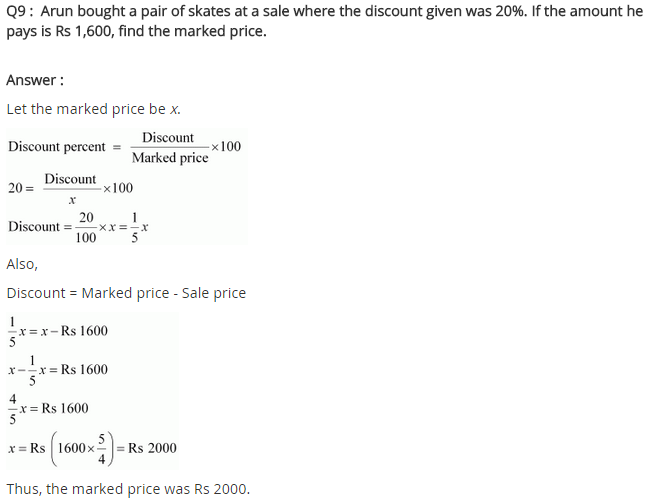

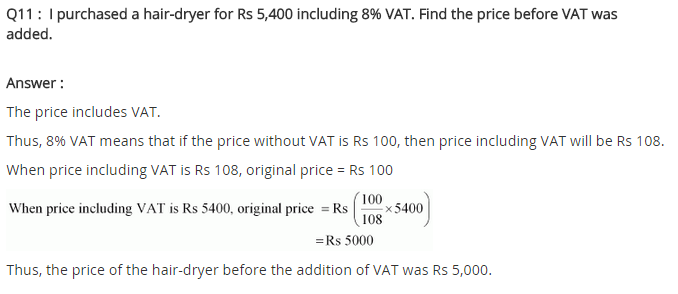

Class 8 Maths Chapter 8 Comparing Quantities Ex 8.3
NCERT Class 8 Maths Chapter 8 Comparing Quantities Ex 8.3 Solutions
NCERT Solutions for Class 8 Maths Chapter 8 Comparing Quantities Exercise 8.3
Ex 8.3 Class 8 Maths Question 1.
Calculate the amount and compound interest on
(a) ₹ 10,800 for 3 years at 12 % per annum compounded annually.
(b) ₹ 18,000 for 2 years at 10% per annum compounded annually.
(c) ₹ 62,500 for 1 years at 8% per annum compounded half yearly.
(d) ₹ 8,000 for 1 year at 9% per annum compounded half yearly. (You could use the year by year calculation using SI formula to verify).
(e) ₹ 10,000 for 1 year at 8% per annum compounded half yearly.
Solution:
(a) Given:
P = ₹ 10,800, n = 3 years,
CI = A – P = ₹ 15,377.35 – ₹ 10,800 = ₹ 4,577.35
Hence amount = ₹ 15,377.34 and CI = ₹ 4,577.34
(b) Given: P = ₹ 18,000, n = 2 years =
years
R = 10% p.a.
The amount for 2 years, i.e., 2 years and 6 months can be calculated by first calculating the amount to 2 years using CI formula and then calculating the simple interest by using SI formula.
The amount for 2 years has to be calculated
Total CI = ₹ 3780 + ₹ 1089 = ₹ 4,869
Amount = P + I = ₹ 21,780 + ₹ 1,089 = ₹ 22,869
Hence, the amount = ₹ 22,869
and CI = ₹ 4,869
(c) Given: P = ₹ 62,500, n = 1 years =
years per annum compounded half yearly
= × 2 years = 3 half years
R = 8% = % = 4% half yearly


CI = A – P = ₹ 70,304 – ₹ 62,500 = ₹ 7,804
Hence, amount = ₹ 70304 and CI = ₹ 7804
(d) Given: P = ₹ 8,000, n = 1 years R = 9% per annum compounded half yearly
Since, the interest is compounded half yearly n = 1 × 2 = 2 half years
CI = A – P = ₹ 8,736.20 – ₹ 8,000 = ₹ 736.20
Hence, the amount = ₹ 8736.20 and CI = ₹ 736.20
(e) Given: P = ₹ 10,000, n = 1 year and R = 8% pa compounded half yearly
Since the interest is compounded half yearly n = 1 × 2 = 2 half years

CI = A – P = ₹ 10,816 – ₹ 10,000 = ₹ 816
Hence the amount = ₹ 10,816 and Cl = ₹ 816
Ex 8.3 Class 8 Maths Question 2.
Kamala borrowed ₹ 26,400 from a Bank to buy a scooter at a rate of 15% per annum compounded yearly. What amount will she pay at the end of 2 years and 4 months to clear the loan? (Hint: Find amount for 2 years with interest is compounded yearly and then find SI on the 2nd
year amount for years).
Solution:
Given:
P = ₹ 26,400
R = 15% p.a. compounded yearly
n = 2 years and 4 months
Amount after 2 years and 4 months = ₹ 34,914 + ₹ 1745.70 = ₹ 36,659.70
Hence, the amount to be paid by Kamla = ₹ 36,659.70
Ex 8.3 Class 8 Maths Question 3.
Fabina borrows ₹ 12,500 at 12% per annum for 3 years at simple interest and Radha borrows the same amount for the same time period at 10% per annum, compounded annually. Who pays more interest and by how much?
Solution:
For Fabina: P = ₹ 12,500, R = 12% p.a. and n = 3 years

Difference between the two interests = ₹ 4500 – ₹ 4137.50 = ₹ 362.50
Hence, Fabina pays more interest by ₹ 362.50.
Ex 8.3 Class 8 Maths Question 4.
I borrowed ₹ 12,000 from Jamshed at 6% per annum simple interest for 2 years. Had I borrowed this sum at 6% per annum compound interest, what extra amount would I have to pay?
Solution:
Given: P = ₹ 12,000, R = 6% p.a., n = 2 years

Difference between two interests = ₹ 1483.20 – ₹ 1440 = ₹ 43.20
Hence, the extra amount to be paid = ₹ 43.20
Ex 8.3 Class 8 Maths Question 5.
Vasudevan invested ₹ 60,000 at an interest rate of 12% per annum compounded half yearly. What amount would he get
(i) after 6 months?
(ii) after 1 year?
Solution:
(i) Given: P = ₹ 60,000, R = 12% p.a. compounded half yearly

Hence, the required amount = ₹ 67416
Ex 8.3 Class 8 Maths Question 6.
Arif took a loan of ₹ 80,000 from a bank. If the rate of interest is 10% per annum, find the difference in amounts he would be paying after
1 years if the interest is
(i) compounded annually.
(ii) compounded half yearly.
Solution:
(i) Given: P = ₹ 80,000
R = 10% p.a.
n = 1 years
Since the interest is compounded annually


Difference between the amounts = ₹ 92,610 – ₹ 92,400 = ₹ 210
Ex 8.3 Class 8 Maths Question 7.
Maria invested ₹ 8,000 in a business. She would be paid interest at 5% per annum compounded annually. Find
(i) The amount credited against her name at the end of the second year.
(ii) The interest for the third year.
Solution:
(i) Given: P = ₹ 8,000, R = 5% p.a.
and n = 2 years
Hence, interest for the third year = ₹ 441
Ex 8.3 Class 8 Maths Question 8.
Find the amount and the compound interest on ₹ 10,000 for 1 years at 10% per annum, compounded half yearly. Would this interest be more than the interest he would get if it was compounded annually?
Solution:
Given: P = ₹ 10,000, n = 1 years
R = 10% per annum
Since the interest is compounded half yearly

Total interest = ₹ 1,000 + ₹ 550 = ₹ 1,550
Difference between the two interests = ₹ 1,576.25 – ₹ 1,550 = ₹ 26.25
Hence, the interest will be ₹ 26.25 more when compounded half yearly than the interest when compounded annually.
Ex 8.3 Class 8 Maths Question 9.
Find the amount which Ram will get on ₹ 4,096, if he gave it for 18 months at 12 per annum, interest being compounded half yearly.
Solution:
Given: P = ₹ 4,096, R = 12 % pa, n = 18 months

Hence, the required amount = ₹ 4913
Ex 8.3 Class 8 Maths Question 10.
The population of a place increased to 54,000 in 2003 at a rate of 5% per annum.
(i) Find the population in 2001.
(ii) What would be its population in 2005?
Solution:
(i) Given: Population in 2003 = 54,000
Rate = 5% pa
Time = 2003 – 2001 = 2 years
Population in 2003 = Population in 2001

Ex 8.3 Class 8 Maths Question 11.
In a Laboratory, the count of bacteria in a certain experiment was increasing at the rate of 2.5% per hour. Find the bacteria at the end of 2 hours if the count was initially 5,06,000.
Solution:
Given: Initial count of bacteria = 5,06,000
Rate = 2.5% per hour
n = 2 hours
Number of bacteria at the end of 2 hours = Number of count of bacteria initially
Thus, the number of bacteria after two hours = 5,31,616 (approx).
Ex 8.3 Class 8 Maths Question 12.
A scooter was bought at ₹ 42,000. Its value depreciated at the rate of 8% per annum. Find its value after one year.
Solution:
Given: Cost price of the scooter = ₹ 42,000
Rate of depreciation = 8% p.a.
Time = 1 year
Final value of the scooter
Hence, the value of scooter after 1 year = ₹ 38,640.

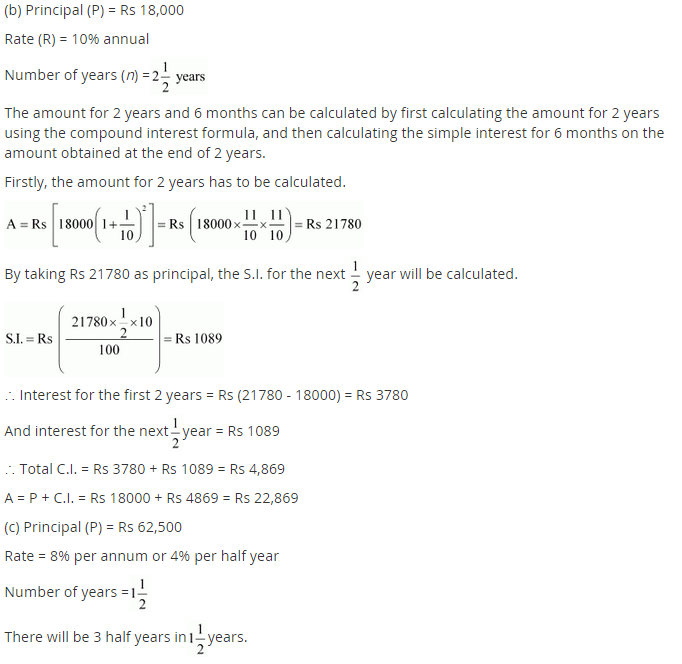

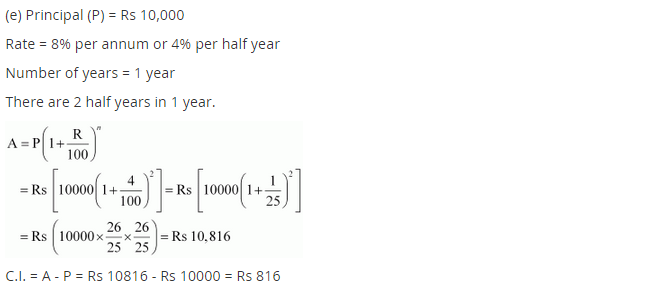


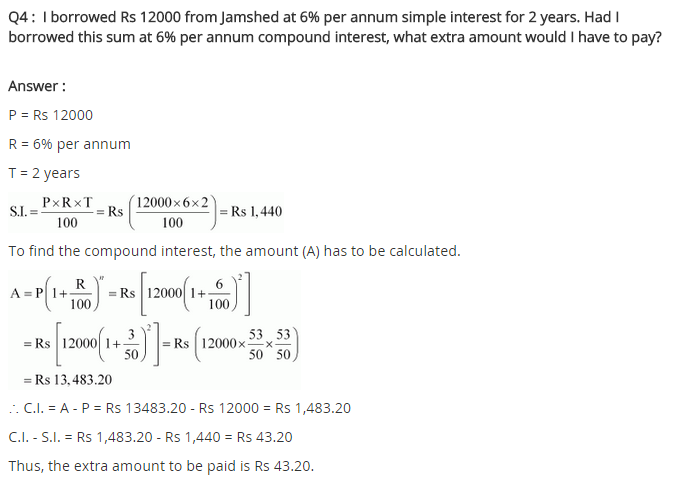


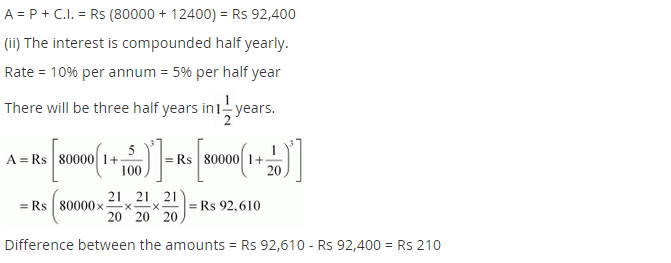
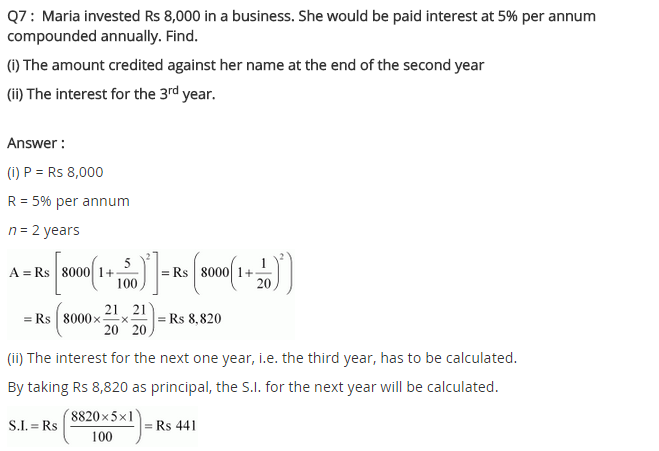



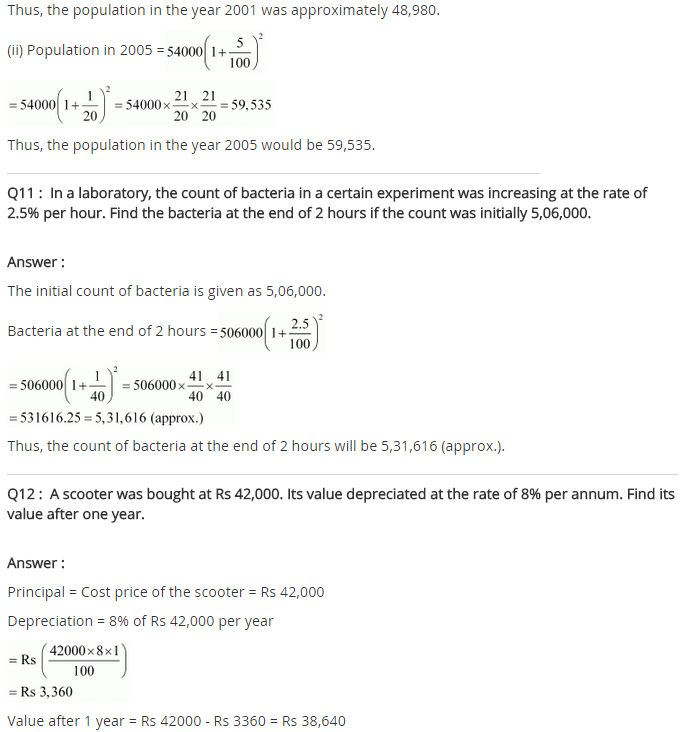

Extra Questions
Comparing Quantities Class 8 Extra Questions Maths Chapter 8
Extra Questions for Class 8 Maths Chapter 8 Comparing Quantities
Comparing Quantities Class 8 Extra Questions Very Short Answer Type
Question 1.
Express the following in decimal form:
(a) 12%
(b) 25%
Solution:
(a) 12% = = 0.12
(b) 25% = = 0.25
Question 2.
Evaluate the following:
(a) 20% of 400
(b) 12% of 625
Solution:
Question 3.
If 20% of x is 25, then find x.
Solution:
20% of x = 25
Hence x = 125
Question 4.
Express the following as a fraction
(a) 35%
(b) 64%
Solution:
Question 5.
Express the following into per cent
(а) 1
(b) 2 : 5
Solution:
Question 6.
There are 24% of boys in a school. If the number of girls is 456, find the total number of students in the school.
Solution:
Let the total number of students be 100.
Number of boys = 24% of 100 = × 100 = 24
Number of girls = 100 – 24 = 76
⇒ If number of girls is 76, then total number of students = 100
⇒ If Number of girls is 1, then total number of students =
If Number of girls is 456, then total number of students = = 600
Hence, the total number of students in the school = 600
Question 7.
The cost of 15 articles is equal to the selling price of 12 articles. Find the profit per cent.
Solution:
Let CP of 15 articles be ₹ 100
CP of 1 article = ₹
SP of 12 articles = ₹ 100
SP fo 1 article = ₹
SP > CP

Hence, profit = 25%
Question 8.
An article is marked at ₹ 940. If it is sold for ₹ 799, then find the discount per cent.
Solution:
MP = ₹ 940
SP = ₹ 799
Discount = MP – SP = 940 – 799 = ₹ 141
Hence, discount = 15%
Question 9.
A watch was bought for ₹ 2,700 including 8% VAT. Find its price before the VAT was added.
Solution:
Cost of watch including VAT = ₹ 2,700
Let the initial cost of the watch be ₹ 100
VAT = 8% of ₹ 100 = ₹ 8
Cost of watch including VAT = ₹ 100 + ₹ 8 = ₹ 108
If cost including VAT is ₹ 108, then its initial cost = ₹ 100
If cost including VAT is ₹ 1, then its initial cost = ₹
If cost including VAT is ₹ 2,700, then its initial cost = ₹ × 2700 = ₹ 2500
Hence, the required cost = ₹ 2,500
Question 10.
Find the amount if ₹ 2,000 is invested for 2 years at 4% p.a. compounded annually.
Solution:

Comparing Quantities Class 8 Extra Questions Short Answer Tpye
Question 11.
A number is increased by 20% and then it is decreased by 20%. Find the net increase or decrease per cent. (NCERT Exemplar)
Solution:
Let the number be 100
20% increase = × 100 = 20
Increased value = 100 + 20 = 120
Now it is decreased by 20%
Decreased value = 120 – × 20 = 120 – 24 = 96
Net decrease = 100 – 96 = 4
Decrease per cent = × 100 = 4%
Hence, the net decrease per cent = 4%
Question 12.
Two candidates Raman and Rajan contested an election. Raman gets 46% of the valid votes and is#defeated by 1600 votes. Find the total number of valid votes cast in the election.
Solution:
Let the total number of valid votes be 100
Number of votes got by Raman = 46% of 100 = × 100 = 46
Number of votes got by Rajan = 100 – 46 = 54
Difference between the votes = 54 – 46 = 8
8% of Valid votes = 1,600
⇒ × Valid votes = 1,600
⇒ Valid votes = = 20,000
Hence, the total number of valid votes = 20,000
Question 13.
A man whose income is ₹ 57,600 a year spends ₹ 43,200 a year. What percentage of his income does he save?
Solution:
Annual income of a man = ₹ 57,600
Amount spent by him in the year = ₹ 43,200
Net amount saved by him = ₹ 57,600 – ₹ 43,200 = ₹ 14,400
Percentage of his annual saving Saving = × 100
= × 100
= 25%
Hence, the saving percentage = 25%
Question 14.
A CD player was purchased for ₹ 3,200 and ₹ 560 were spent on its repairs. It was then sold at a gain of 12 %. How much did the seller receive?
Solution:
Cost price of the CD player = ₹ 3,200
Amount spent on its repairing = ₹ 560
Net cost price = ₹ 3,200 + ₹ 560 = ₹ 3,760
Hence, the required amount = ₹ 4,230
Question 15.
A car is marked at ₹ 3,00,000. The dealer allows successive discounts of 6%, 4% and 2 % on it. What is the net selling price of it?
Solution:
Marked price of the car = ₹ 3,00,000
Net selling price after the successive discounts
Hence, the net selling price = ₹ 2,63,952
Question 16.
Ramesh bought a shirt for ₹ 336, including 12% ST and a tie for ₹ 110 including 10% ST. Find the list price (without sales tax) of the shirt and the tie together.
Solution:
List price of the shirt = × 336 = ₹ 300
List price of the tie = × 110 = ₹ 100
List price of both together = ₹ 300 + ₹ 100 = ₹ 400
Question 17.
Find the amount of ₹ 6,250 at 8% pa compounded annually for 2 years. Also, find the compound interest.
Solution:
Question 18.
Find the compound interest on ₹ 31,250 at 12% pa for 12 years.
Solution:
Question 19.
Vishakha offers a discount of 20% on all the items at her shop and still makes a profit of 12%. What is the cost price of an article marked at ₹ 280? (NCERT Exemplar)
Solution:
Marked Price = ₹ 280
Discount = 20% of ₹ 280
= × 280 = ₹ 56
So selling price = ₹ (280 – 56) = ₹ 224
Let the cost price be ₹ 100
Profit = 12% of ₹ 100 = ₹ 12
So selling price = ₹ (100 + 12) = ₹ 112
If the selling price is ₹ 112, cost price = ₹ 100
If the selling price is ₹ 224, cost price = ₹ ( × 224) = ₹ 200
Question 20.
Find the compound interest on ₹ 48,000 for one year at 8% per annum when compounded half yearly. (NCERT Exemplar)
Solution:
Principal (P) = ₹ 48,000
Rate (R) = 8% p.a.
Time (n) = 1 year
Interest is compounded half yearly
Therefore Compound Interest = A – P = ₹ (519,16.80 – 48,000) = ₹ 3,916.80.



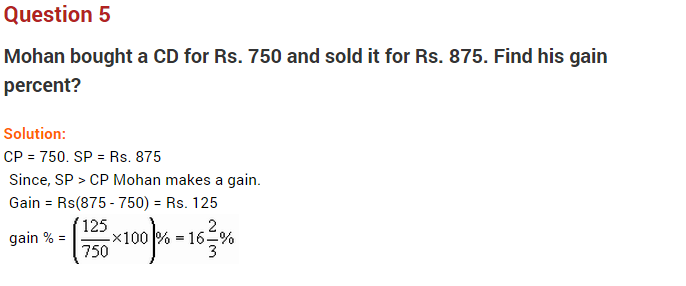

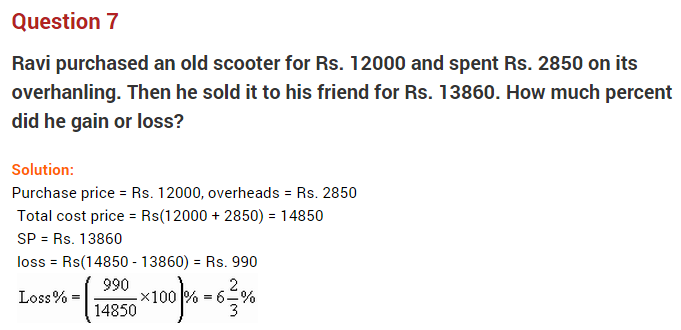

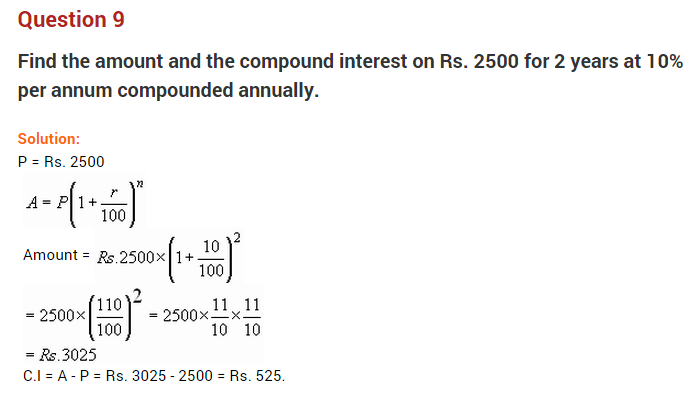
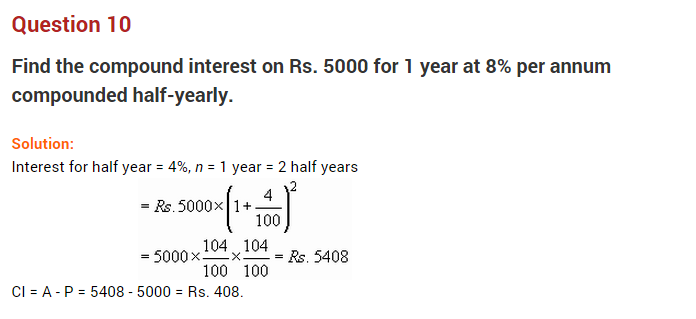

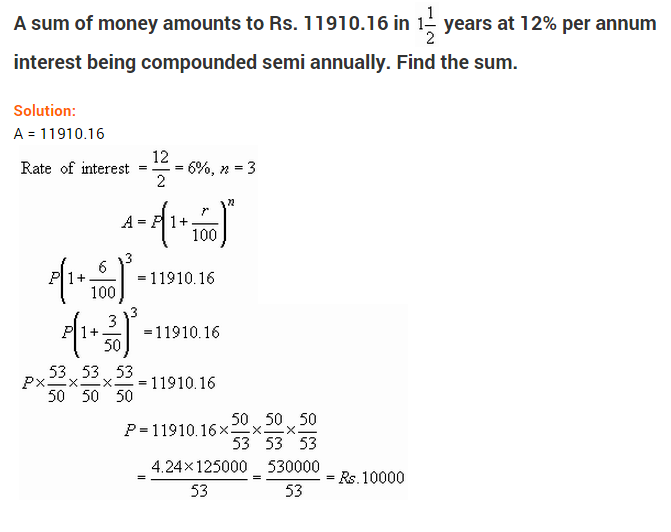







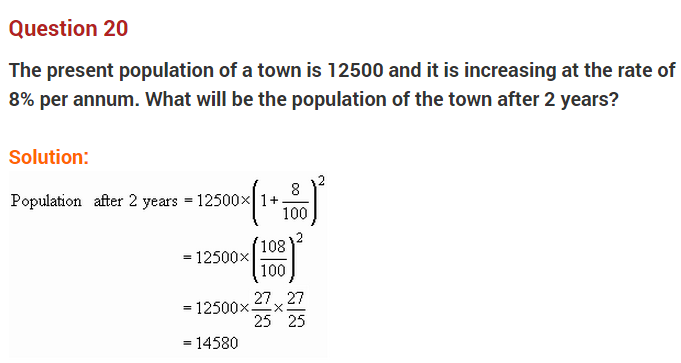
NCERT Solutions for Class 8 Maths
- Chapter 1: Rational Numbers
- Chapter 2: Linear Equations in One Variable
- Chapter 3: Understanding Quadrilaterals
- Chapter 4: Practical Geometry
- Chapter 5: Data Handling
- Chapter 6: Squares and Square Roots
- Chapter 7: Cubes and Cube Roots
- Chapter 8: Comparing Quantities
- Chapter 9: Algebraic Expressions and Identities
- Chapter 10: Visualising Solid Shapes
- Chapter 11: Mensuration
- Chapter 12: Exponents and Powers
- Chapter 13: Direct and Indirect proportions
- Chapter 14: Factorisation
- Chapter 15: Introduction to Graphs
- Chapter 16: Playing with Numbers


